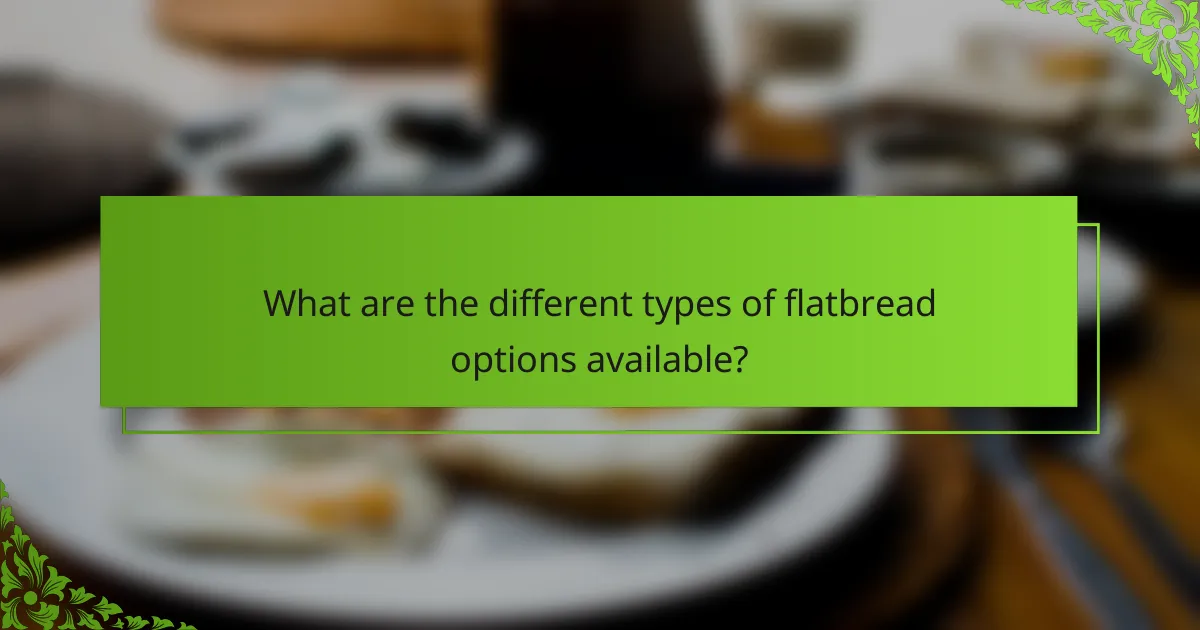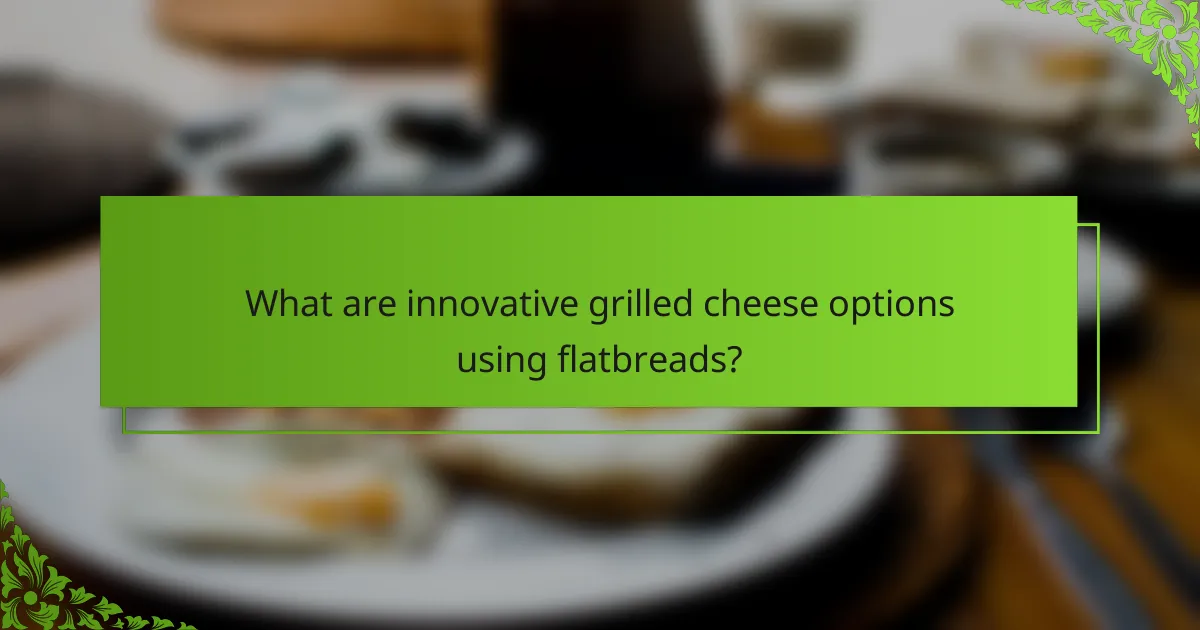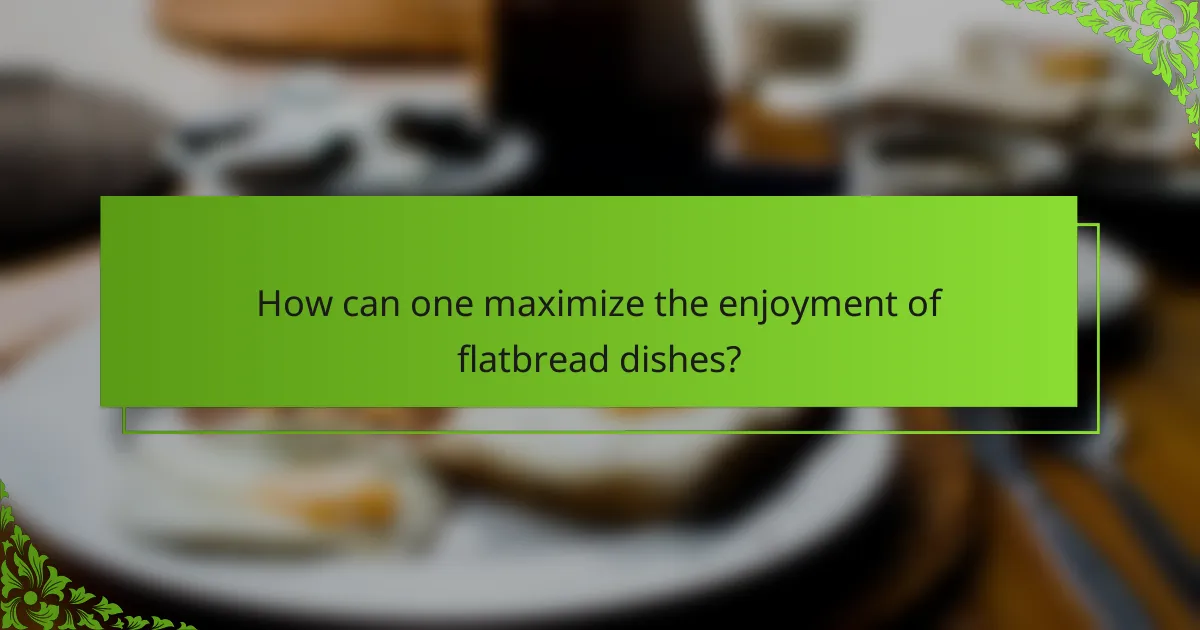Flatbread is a versatile culinary entity that encompasses various types, including pita, naan, lavash, and focaccia, each with distinct characteristics and uses. The article explores innovative grilled cheese options that utilize these flatbreads, featuring combinations such as Mediterranean grilled cheese with feta and spinach, spicy pepper jack with avocado, breakfast-inspired versions with eggs and cheddar, and sweet variations with mascarpone and fruit preserves. Additionally, it emphasizes the importance of fresh ingredients, diverse toppings, and cooking methods to enhance the flatbread experience. Complementary dips and spices are suggested to elevate flavor, while serving warm and focusing on presentation can further enhance enjoyment.

What are the different types of flatbread options available?
There are several types of flatbread options available. Common varieties include pita, naan, lavash, and focaccia. Pita is a Middle Eastern flatbread that is often pocketed. Naan is a soft, leavened flatbread traditionally cooked in a tandoor oven. Lavash is a thin, unleavened flatbread popular in Armenian and Middle Eastern cuisines. Focaccia is an Italian flatbread, usually seasoned with olive oil and herbs. Each type of flatbread has unique characteristics and uses in various culinary applications.
How do various flatbread types differ in preparation and ingredients?
Various flatbread types differ in preparation and ingredients based on regional traditions and specific recipes. For instance, naan is traditionally made with yeast, resulting in a soft, leavened bread. It is often cooked in a tandoor oven, giving it a unique texture and flavor. In contrast, pita is made with a simpler dough of flour, water, and salt, which is baked at high temperatures to create a pocket.
Another example is lavash, which is a thin, unleavened flatbread made with flour and water. It is typically rolled out very thin and cooked on a hot surface, resulting in a crispy texture. Tortillas, originating from Mexico, are made from masa harina or wheat flour, and can be either soft or crispy, depending on the cooking method.
Focaccia, an Italian flatbread, includes olive oil and is often topped with herbs before baking, giving it a rich flavor. Each type of flatbread showcases distinct preparation methods and ingredient combinations, reflecting cultural influences and culinary practices.
What are the unique attributes of traditional flatbreads?
Traditional flatbreads have several unique attributes. They are typically unleavened, resulting in a denser texture. These breads are often made with whole grains, contributing to their nutritional value. Many traditional flatbreads are cooked on hot surfaces, such as stones or griddles. This method imparts a distinct flavor and char. Additionally, they are versatile and can be used as wraps or accompaniments to various dishes. Historical evidence shows that flatbreads have been consumed for thousands of years across different cultures. This long-standing tradition highlights their importance in global cuisine.
How do modern variations of flatbreads enhance versatility?
Modern variations of flatbreads enhance versatility by offering a diverse range of flavors, textures, and uses. These flatbreads can be made from various grains, such as whole wheat, spelt, or gluten-free alternatives. This variety allows for dietary preferences and restrictions to be accommodated.
Additionally, modern flatbreads can be infused with herbs, spices, or seeds, further expanding their flavor profiles. The introduction of toppings and fillings has transformed flatbreads into meal bases, snacks, or appetizers.
Techniques like grilling, baking, or frying add unique textures that complement different dishes. This adaptability makes flatbreads suitable for cuisines worldwide, from Mediterranean to Asian influences.
Recent trends also include using flatbreads as wraps or pizza bases, enhancing their culinary applications. Overall, these innovations position flatbreads as a flexible option in contemporary cooking.
What cooking methods can be used for flatbreads?
Flatbreads can be cooked using various methods. Common methods include baking, grilling, and frying. Baking is often done in an oven or on a stone. Grilling involves cooking flatbreads on a hot grill or griddle. Frying can be performed in oil or on a skillet. Each method produces distinct textures and flavors. Baking yields a crisp exterior with a soft interior. Grilling imparts a smoky flavor and char marks. Frying results in a crispy texture. These methods are widely used in different cuisines around the world.
How does baking affect the texture and flavor of flatbreads?
Baking significantly alters the texture and flavor of flatbreads. The high heat causes the moisture in the dough to evaporate, resulting in a firmer texture. This process also creates a crisp outer layer while maintaining a soft interior. Additionally, baking caramelizes the sugars in the dough, enhancing the flavor profile. The Maillard reaction occurs during baking, contributing to a richer taste. Different baking temperatures and times can lead to variations in texture, such as chewy or crunchy. Baking methods, like using a stone oven, can further impact the final product’s characteristics. Thus, baking is crucial in developing the desired attributes of flatbreads.
What are the benefits of grilling flatbreads compared to other methods?
Grilling flatbreads offers distinct benefits over other cooking methods. It imparts a unique smoky flavor that enhances the overall taste. The high heat from grilling creates a crispy texture while keeping the interior soft. Grilling also allows for quick cooking, reducing preparation time. Nutrient retention is often better due to the shorter cooking duration. Additionally, grilling can create attractive grill marks, improving presentation. This method is versatile, accommodating various toppings and flavors. Grilled flatbreads can be enjoyed as appetizers or main dishes, making them adaptable for different occasions.
What flavor enhancements can be added to flatbreads?
Flavor enhancements that can be added to flatbreads include herbs, spices, cheeses, and toppings. Common herbs are rosemary, thyme, and oregano. These herbs add aromatic qualities and depth of flavor. Spices like garlic powder, cumin, and paprika can create a savory profile. Cheeses such as feta, mozzarella, or goat cheese provide creaminess and richness. Toppings like olives, sun-dried tomatoes, or caramelized onions add texture and additional taste. Infused oils or flavored butters can also be brushed on for extra flavor. Each enhancement contributes to a unique taste experience in flatbreads.
How do herbs and spices transform the taste of flatbreads?
Herbs and spices significantly enhance the taste of flatbreads. They introduce complex flavors and aromas that elevate the overall eating experience. Common herbs like rosemary and thyme add earthy notes. Spices such as cumin and coriander provide warmth and depth.
These additions can also create regional variations in flatbreads. For instance, za’atar is a popular blend in Middle Eastern flatbreads. It combines thyme, sumac, and sesame seeds for a unique flavor profile.
The use of herbs and spices can also influence the perceived freshness of flatbreads. Fresh herbs impart a vibrant taste that can brighten the dish. Dried spices, on the other hand, can add a more robust flavor.
Incorporating these elements can transform a simple flatbread into a gourmet product. This versatility makes flatbreads appealing in various culinary contexts.
What role do toppings play in enhancing flatbread flavor?
Toppings significantly enhance flatbread flavor by adding diverse tastes and textures. They introduce contrasting flavors such as savory, sweet, or spicy. Ingredients like herbs, cheeses, and meats provide depth and complexity. Fresh vegetables contribute crunch and freshness. Toppings also create visual appeal, making the dish more appetizing. The combination of toppings can elevate a simple flatbread to a gourmet experience. Research indicates that flavor pairing can enhance overall satisfaction in food consumption. Therefore, toppings play a crucial role in maximizing the sensory experience of flatbread.

What are innovative grilled cheese options using flatbreads?
Innovative grilled cheese options using flatbreads include various combinations of ingredients and flavors. One option is a Mediterranean grilled cheese with feta, spinach, and sun-dried tomatoes. This combination offers a unique taste profile compared to traditional cheese sandwiches. Another option is a spicy pepper jack and avocado grilled cheese, providing a creamy texture with a kick.
Additionally, a breakfast-inspired grilled cheese can be made with scrambled eggs and cheddar on flatbread. This twist caters to morning cravings while maintaining the classic grilled cheese essence. For a sweet variation, consider a dessert grilled cheese with mascarpone and fruit preserves, appealing to those with a sweet tooth.
These innovative options showcase how flatbreads can enhance the traditional grilled cheese experience through diverse flavors and ingredients.
How can flatbreads be used creatively in grilled cheese recipes?
Flatbreads can be used creatively in grilled cheese recipes by serving as a versatile base. They can replace traditional bread, offering unique textures and flavors. Flatbreads, such as naan or pita, provide a chewy consistency that complements melted cheese. They can also be stuffed with various fillings, enhancing the flavor profile. For instance, adding herbs or spices to the flatbread can elevate the dish. Additionally, flatbreads can be grilled or toasted to achieve a crispy exterior. This method creates a delightful contrast with the gooey cheese inside. The use of flatbreads allows for endless combinations, such as incorporating vegetables or meats. This creativity in grilled cheese recipes caters to diverse dietary preferences and tastes.
What unique combinations of ingredients elevate grilled cheese with flatbreads?
Unique combinations of ingredients that elevate grilled cheese with flatbreads include various cheeses, spreads, and toppings. For instance, using smoked gouda and caramelized onions enhances flavor complexity. Adding pesto or sun-dried tomatoes introduces a fresh, herby taste. Incorporating avocado or arugula adds creaminess and a peppery bite. Using flatbreads like naan or lavash provides a different texture compared to traditional bread. Each combination contributes to a unique culinary experience. The versatility of flatbreads allows for endless ingredient pairings, making grilled cheese innovative and exciting.
How does the choice of flatbread impact the overall grilled cheese experience?
The choice of flatbread significantly influences the overall grilled cheese experience. Flatbread affects texture, flavor, and structural integrity. For instance, a thicker flatbread provides a hearty crunch, while thinner varieties can offer a delicate crispness. The flavor profile of the flatbread also complements the cheese. Whole grain flatbreads add nuttiness, while herb-infused options enhance the overall taste. Additionally, flatbread’s moisture retention can impact the meltiness of the cheese. A drier flatbread may lead to a less satisfying melt, while a more moist option can create a gooey texture. Ultimately, the choice of flatbread can elevate or diminish the enjoyment of a grilled cheese sandwich.
What are some popular flatbread grilled cheese variations?
Popular flatbread grilled cheese variations include Mediterranean, pesto, and spicy pepper jack. Mediterranean variations often feature feta, olives, and sun-dried tomatoes. Pesto flatbread grilled cheese incorporates basil pesto and mozzarella for a fresh flavor. Spicy pepper jack adds heat with jalapeños and pepper jack cheese. Each variation enhances the classic grilled cheese experience. These combinations are widely appreciated for their unique tastes and textures.
Which international flavors can be incorporated into flatbread grilled cheese?
International flavors that can be incorporated into flatbread grilled cheese include Mediterranean, Mexican, Indian, and Asian influences. Mediterranean flavors can be achieved with ingredients like feta cheese, olives, and sun-dried tomatoes. Mexican flavors can be introduced using pepper jack cheese, jalapeños, and avocado. Indian flavors may include paneer, curry spices, and chutney. Asian influences can be incorporated with ingredients like kimchi, sesame oil, and soy sauce. Each of these flavors enhances the traditional grilled cheese experience by adding unique tastes and textures.
How can seasonal ingredients be utilized in flatbread grilled cheese recipes?
Seasonal ingredients can enhance flatbread grilled cheese recipes by incorporating fresh produce that reflects the time of year. For example, in spring, asparagus and radishes can add crunch and flavor. Summer offers tomatoes and zucchini, which provide juiciness and sweetness. In fall, ingredients like butternut squash and apples can introduce warmth and depth. Winter allows for the use of hearty greens like kale and root vegetables for a satisfying texture. Seasonal ingredients not only improve taste but also ensure freshness and nutritional value. Utilizing local farmers’ markets can help source these ingredients at their peak, enhancing the overall quality of the grilled cheese.

How can one maximize the enjoyment of flatbread dishes?
To maximize the enjoyment of flatbread dishes, focus on using fresh ingredients and diverse toppings. Fresh herbs, high-quality cheeses, and seasonal vegetables enhance flavor. Experiment with different cooking methods like grilling or baking for varied textures. Pair flatbreads with complementary dips such as hummus or tzatziki for added taste. Incorporating spices can elevate the overall experience. For example, a sprinkle of za’atar can introduce a unique flavor profile. Serving flatbreads warm enhances their aroma and taste. Engaging in presentation also plays a role; visually appealing dishes can stimulate appetite.
What are some best practices for preparing and serving flatbreads?
Prepare flatbreads by using fresh ingredients and appropriate techniques. Start with high-quality flour for better texture. Knead the dough thoroughly to develop gluten. Allow the dough to rest for optimal elasticity. Roll the dough evenly to ensure uniform cooking. Preheat the cooking surface to achieve a crispy exterior. Cook flatbreads quickly on high heat for best results. Serve flatbreads warm to maintain their softness. Pair with complementary toppings for enhanced flavor.
How can one troubleshoot common issues when cooking flatbreads?
To troubleshoot common issues when cooking flatbreads, identify the specific problem first. If flatbreads are too tough, check the dough hydration. Insufficient moisture can lead to dryness. Conversely, if they are too soggy, reduce water in the dough. For uneven cooking, ensure the cooking surface is adequately heated. An underheated pan can cause uneven browning. If flatbreads stick, use sufficient flour on the surface and the rolling pin. Additionally, allow the dough to rest before rolling to improve elasticity. For burning, lower the cooking temperature and monitor the cooking time closely. These adjustments can help achieve the desired texture and flavor in flatbreads.
What tips can enhance the overall experience of enjoying flatbread meals?
To enhance the overall experience of enjoying flatbread meals, focus on flavor pairings and presentation. Pair flatbreads with complementary toppings like fresh vegetables, cheeses, and herbs. Use high-quality ingredients to elevate taste. Experiment with various cooking methods such as grilling or baking for different textures. Serve flatbreads warm for optimal enjoyment. Consider adding dips like hummus or tzatziki for added flavor. Presentation matters; arrange flatbreads attractively on a platter. Incorporate seasonal ingredients for freshness. Lastly, engage in a communal dining experience to share and enjoy together.
Flatbread is a versatile culinary entity encompassing various types such as pita, naan, lavash, and focaccia, each with distinct preparation methods and ingredient profiles. This article explores the differences in flatbread preparation, the unique attributes of traditional varieties, and modern innovations that enhance their versatility, including cooking methods like baking and grilling. Additionally, it examines flavor enhancements through herbs, spices, and toppings, as well as innovative grilled cheese recipes utilizing flatbreads. Practical tips for preparation and serving, along with troubleshooting common cooking issues, are also provided to maximize the enjoyment of flatbread dishes.